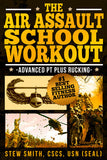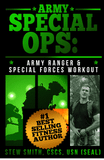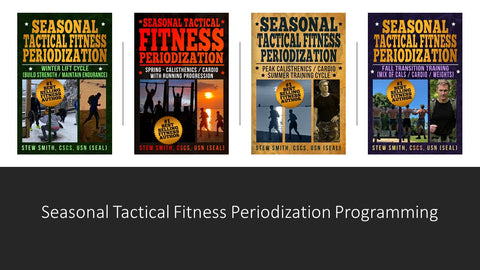Crush the AFSW IFT- Learn HOW to Build a Strategy to Optimal Performance
This article is to inform you of changes to many of the fitness tests, but also to help you create a strategy to crushing them - specifically the new Air Force Special Warfare Initial Fitness Test (IFT). Several years ago, I created the Navy PST Clinic which breaks down the PST into more than 20 assessment points for only five events (swim, pushups, situps, pullups, run). This is a specific answer to breaking down the NEW Air Force PAST for Air Force Special Warfare applicants similarly to the clinic above BUT it is different due to the complete different order of the events. However, the similarities lie with how you take advantage of the transition periods and pace each event of the PAST.
Building a Strategy to Test Taking (Not Training for the Test)
The Navy PST Clinic has been a popular article for many people who are wanting to crush the pst (#crushthepst). Over the years, PT tests within the military have changed completely with new exercises like the Army CFT, the USMC CFT addition, as well as the order of the Air Force Special Warfare PAST.
Because of changes of the above tests as well as the changes from crunches to plank poses for regular military (Navy, Air Force, Army, USMC included), changes to how you prepare must occur as well as changes to how you actually strategize to the tests must occur.
*NOTE - Navy Special Warfare / Operations PST and the Air Force Special Warfare IFT still do situps, so you will need to get good at both on your journey from basic training / boot camp and regular military service as you transfer into the special ops worlds.
Here is a breakdown of the Air Force IFT Test, the Official IFT Form and minimum standards for all the jobs within the Air Force Special Warfare Open Enlistment (SWOE): See PDF above for complete details or chart for changes in order and minimum standards as of April 2020.
Minimum Initial Fitness Test (IFT) for Air Force Special Warfare
|
AF IFTEVENTS |
SWOE / Active Duty (AD): |
SERE |
|
Pullups 2 min |
8 |
8 |
|
Situps 2min |
50 |
48 |
|
Pushups 2 min |
40 |
40 |
|
1.5 mile run |
10:20 |
11:00 |
|
2 x 25m u/w swim |
Pass/fail |
not tested |
|
500m swim (free or breast, sidestroke) |
15:00 / 12:30 (AD) |
not tested |
|
The most important similarity with the PT Test and the follow on training programs is you cannot be a good student with these minimum standards. These are JUST MINIMUM standards however, no one makes it through on minimum standards. You need to be better. In fact, I personally would strive for the following standards on either test: GOALS 500yd / 500m swim – 8:20 (a meter or yard per second pace) |
||
The Calisthenics Exercises Are FIRST in the NEW IFT

This means you should do a normal warmup, dynamic stretches that you would normally do prior to any upper body workout. Being warmed up and ready to max out these events is important. Typical warmups can take 10-15 minutes of a mix of running, light dynamic stretching, a few reps of the actual exercises tested, and deep breathing.
Even though they call this section the Strength Section of the IFT, it is truly a strength-endurance test - a muscle stamina test. Your ability to do multiple repetitions of each of these exercises without fail has a strength component to it BUT to ace this test you have to be able to take these traditional strength exercises and make it an endurance exercise. The hardest event of this section is the pullup as it requires the most strength (full body weight to lift).
First event of the Air Force IFT(PULLUPS)

Going in fresh to the pullups is a nice difference between most PT tests, however, these are PERFECT Pullups on the instructors cadence of UP / DOWN so you really have to bring your A game to this event to max it. Exert on the up and try not to waste much time and energy returning to the down position but keep your shoulders racked so you are not completely relaxing your shoulders in the down position. Engage the back and biceps on this movement and work to keep your body rigid through the movement to prevent swinging or kipping
The slower you go on these reps the more gravity takes it out of you so when the instructor says DOWN - get down fast and be waiting for his UP command.
Tips for More Reps: For the Pull-ups, Sit-ups, Pushups, let gravity take you down so do not waste energy slowly letting yourself to the down position - so you are just exerting on the UP movement.
Two Minute Rest Period - After max pullup sets, work to loosen your arms and shoulders and chest to prepare yourself for the next two events. Stretch your lower back and keep loosening your shoulders as much as you can. Sip on a carbohydrate drink and avoid caffeinated drinks or supplements as that only elevates your heart rate artificially and will cause you to lose your pace.
Second event of the Air Force IFT (SITUPS)

Situps - For the IFT, lie on your back with your arms over your head and hand interlocked behind your head. Keep your knees slightly bent. Raise your upper body off the floor by flexing your hip flexors and abdominal muscles until your back is vertical to the floor and repeat. During the IFT, someone will be counting and holding your feet for you.
PACE YOURSELF: The most important thing is to pace your situps. Too many times people start out too fast and do about 30-40 in the first 30 seconds and not being able to get 30-40 in the next 1:30 in a 2:00 test. That tells me that you started out too fast. If your goal is 80-100 in a 2:00 period, you should pace yourself at 20-25 in 30 seconds and 40-50 in 1:00. Your workouts should include timed sets so you can master this pace and build stamina to maintain it.
Two Minute Rest Period - Stretch your stomach, hips, and arms to prepare for the pushup test.
Third event of the Air Force PAST (PUSHUPS)

Pushups - Proper stance. Your hands should be about shoulder width apart. Lie on the floor with your hands even with your chest and hands just outside shoulder width. Too many people place their hands too high or too low, which will weaken your push-ups tremendously. The down position is when your elbow reaches 90° angle. The up position (also rest position) is when your arms are straight as well as your back.
PS - if you ever start shaking uncontrollably during the final half minute of your pushup test, DO NOT try to get any more reps. When you are shaking you are wasting A LOT of energy that you will need for the remaining exercises of the test AND you will likely not even get 1-2 pushups once you start shaking. It is recommended to just fall on your chest / knees and your test is done.
Related Articles: Pushup Push Workout, Pushups
Ten Minute Rest Period - This is when transition training comes in handy. Are your runs slower after the PT section of the test than just running? See related article - Is Your Run Always Worse After PT tests? After you perform the PT test, take the time in between the upper body exercises to stretch the arms, chest, shoulders, stomach and lower back. Then run for about 4 to 5 minutes at an easy pace while stretching and shaking out your arms to get the blood down toward your legs. Finally, take about 3 to 5 minutes to stretch your legs. Keep shaking the arms, throughout the time in between the PT and run, to loosen up.
Fourth event of the Air Force IFT (1.5 mile run)
The run is ALL about pacing, similar to situps. If you start out too fast on the first lap (400m), the next 5 laps of the 1.5 mile run will continue to get slower to the point you will be lapped by people you were ahead of on the first lap time. PACE YOURSELF! What is your goal pace? Learn it:
6 minute mile pace: This should be your goal in my opinion or faster: If you want a 6 minute mile or 9 minute 1.5 mile run time - shoot for 1:30 400m or quarter mile run. Practice this goal pace so much that it is easy to "FEEL" your pace as starting out too fast will crush your performance.
If you want a 7 minute mile or 10:30 1.5 mile run time, shoot for a 1:45 400m or quarter mile. But that is failing, so you have to get faster than this by 10 seconds. It is best not to have a minimum standard as your goal and be able to easily do a six minute mile pace. This may take more time and conditioning so do not be in a rush to join if you suck at running (8 minute miler).
Have someone record your six 400m split times and see where you are falling off your pace. You will see if you start off too fast and where you start to slow by doing this drill. Then train at those those distances with 800m, 1200m or 1600m repeat workouts at that goal pace.
Check out this article to help with six minute miles for timed runs and a 7 minute mile for longer distance runs (4-5+ miles)
Running Program to get TO and THROUGH Selection (FREE)

Spec Ops Running / Rucking Plan (Advanced)
Week 1 is 15 miles per week and builds up to 35 miles per week
30 Minute Rest Period - This is a long rest period that can get you stiff and not ready to swim if you sit around. My advice is to get into the pool or take a long transition shower prior to entering the pool with cold water and get your body temperature down. I have found by swimming last in my normal workouts, the pool will reduce your body temperature quickly and you will feel like you are on a second wind as half of your fatigue is body heat.
Then swim a few laps and loosen the shoulders and legs as you will be making powerful kicks and pulls to get across the pool in both the underwater swims and the 500m swim. Stretching will also help you with your shoulder mobility - see some of these stretches in the swimming mobility streamline article.
Fifth event of the Air Force IFT (U/W Swims)
Underwater swimming is ALL technique so it requires practice that will also get you in the pool practicing regularly. This near daily swim workout should be a mix of conditioning swims (with and without fins), treading water, underwater swims, snorkel buddy breathing, and drownproofing. To be honest, the 2 x 25m underwater swims are the easiest of the list above ONCE you figure out the stroke and can do it efficiently (4-5 strokes max for 25m).
Tips: Practice your streamline position and breast stroke pullout
Ten Minute Rest Period
Sixth event of the Air Force IFT (500m Swim)
Personally, if you are a swimmer and know the crawl stroke, it will be much faster for you, but it requires more swim conditioning vs the side stroke options. If you can get good at the side strokes (CSS or elementary side) you will find it moderately fast with some time practicing both technique and conditioning with workouts like the 50-50 Swim Workout. But first, do not waste your swim time without getting the proper technique training and critiques of the crawl stroke / freestyle or side stroke. See Freestyle tutorial and CSS Stroke Sequence. Both require the FREESTYLE CATCH for the arm pull and good streamline.
My advice is similar to the running pace advice. Learn your GOAL PACE. If you want to swim an 8:20 - that is 500m in 500 seconds. Easy to do the math on this one each lap. But you need to master the technique then the conditioning to maintain ten laps of the swim (in a 25m pool). Have someone record your ten 50m split times and see where you are falling off your pace. Then make your workout intervals longer to where you start to fail and build up your conditioning so you can handle that distance for multiple sets.
Optimal Performance Cues
When you have one of those days that you absolutely crush everything and hit some personal records (PRs) on multiple events, do a quick 24 hour assessment of the following:
How did you sleep (time, quality)?
What did you eat for dinner the day before? Morning of test?
How much did you hydrate? Electrolyte replacement?
What were your workouts three days prior to the test? Intense? Leg Day? Cardio?
What was the temperature of the test day?
What did you drink during the IFT Test? Water? Sugar replacement? Electrolytes?
Now if you have a crap day, do the same thing and see if you can figure out why your performance was good or bad. Finding the right combination of sleep, training, recovery, nutrition, and prep is the goal of getting TO the training.
But if you want to get THROUGH the training / selection, you have to keep progressing with your training and get specific to the events of your future selection. Usually that means longer runs, rucks, and swims with fins. Top it off with pool skills, water confidence, underwater swims, and treading and you have most of the challenging performance events experienced prior to being in the military.
Some Things to Practice Prior to Joining the Military
The Combat Swimmer Stroke with Fins
NAVY Method - You can use the arms to pull and can be timed with your breathing. Top leg always goes forward when doing flutterkicks / scissor kicks though you may find the smaller flutterkicks work better than a big scissor kick and little flutters in between. Your choice how you do to.
Air Force Method - You use a Lead Arm / Trail Arm Side Stroke Method so you cannot move your arms during this LATA Side Stroke swim in the Air Force.
Pool Skills
At both BUD/s and the AFSW Assessment and Selection Courses and especially following training (especially PJ), you will be doing a lot of swimming (with / without fins), no hand treading, weighted treading, underwater swims, and some hardcore water competency training. Drown proofing, treading, multiple underwater swims, and snorkel buddy breathing are the killers at Air Force training. Whereas at BUDS, you will also have drownproofing, instructor life saving (aka underwater wrestling), underwater knot tying on breath holds (15ft deep), and as you master SCUBA diving in second phase, you will have Pool Comp (OC8) which is also underwater wrestling to a degree on SCUBA.
Both programs (Air Force and Navy Special Warfare) have recruiting programs that will test your abilities while in the Delayed Entry Program (DEP) and you should be able to crush these tests with some basic preparation and testing focus. Once you have passed the test, now you need to get good enough to be well over the minimum standards as well as focus on other events you will encounter such as longer swims, pool skills, longer runs, rucks, and other load bearing activities.
Special Ops Level Tactical Fitness Training Ideas
Learn How to do Seasonal Periodization to Build Tactical Athlete Skills
Twelve Questions / Answers About Mental Toughness
Quitting or Not Quitting - The Choice is YOURS
Getting TO and THROUGH Training (Two Phases of Tactical Fitness)
If you want help, that’s what I do…. Check out these resources that have helped spec ops candidates succeed where others have failed for the last 20+ years!
Training is What We Do:
Need Programming for Fitness Tests and Beyond? We are all about getting you TO and THROUGH your future training program. See how that works.
There is More To StewSmithFitness.com than a You May Know
(In fact, there are more than 40 books, 1000+ articles, online coaching - and more)

Who is Stew Smith CSCS? Coach, Trainer, Writer, Podcaster: I'm the former Navy SEAL that tactical candidates go to for books, ebooks and online coaching to prepare themselves to get to and through intense tactical assessment and selection programs and qualify for service in their chosen tactical profession. See More at StewSmithFitness.com
Where to Find More Information About Optimal Performance Training Programs
When you start training again, consider the seasonal tactical fitness model. I call it A WAY to train and obviously not the only way to train. But it offers the opportunity to never neglect your weaknesses, helps with flexibility and mobility, but will also put you at a level of physical abilities where you are happy with your overall ability to do just about anything. We have a system where the seasons dictate our training. When it is nicer outside, we tend to run and do more calisthenics. When it is colder and not so nice, we lift more, run less, and still maintain our outdoor activities with shorter runs and rucks. Check it out: Seasonal Tactical Fitness Periodization System.
These Seasonal Tactical Fitness BLOCK Periodization programs will walk you through 4 x 4 weeks cycles with 16 weeks of each season in two programs. (32 total weeks)

Increase Strength & Crush the PST / PAST
3 Weeks Strength - 1 Week PT / Cardio Focus
(16 weeks)
These programs will walk you through 4 cycles with 12 weeks of each season in two programs.
The Specific Military / Special Ops Physical Fitness Workouts
Navy SEAL Workout Phase 1
Navy SEAL Workout Phase 2 - 3
Navy SEAL Workout Phase 4 Grinder PT
Navy SWCC Workout
Army / Air Force Advanced Fitness / Special Ops
Army PFT Workout (Prep For Rucking, OPAT, ACFT)
Army Special Forces / Ranger Workout
Army Air Assault School Workout
Army Airborne Workout
Air Force Special Warfare IFT / OFT / Selection Prep






Advanced Running Program - Special Ops Supplement Plan
USMC RECON / MarSOC Workout
USMC OCS / TBS Workout
USMC IST and PFT
The Combat Conditioning Workout
Air Force PJ / CCT Workout Battlefield Airman Prep Course
The UBRR Upper Body Round Robin Workout / Spec Ops version
The Coast Guard Rescue Swimmer / Navy SAR Workout
The Service Academy Workout (West Point, Navy, Air Force Academy)
The Navy, Air Force, Marine Corp Boot Camp Workout
The Law Enforcement Physical Fitness Workouts
The FBI Academy Workout | FBI Workout Vol 2
The DEA Workout
The FLETC Workout - Ace the PEB
The PFT Bible: Pushups, Sit-ups, 1.5 Mile Run
The Fire Fighter Workout - Ace the CPAT
Online Coaching Options
Online PT CLUB - Weekly Workouts created personally for you.
New Member's Only Content / Services Program!
If you want access to years worth of workouts, many of the top eBOOKs, favorite workouts of the week, free fitness APP, closed Facebook Group, video / picture library of exercises, and more access to LIVE Q/A sessions check out the Stew Smith Fitness Members Section.
The dashboard below has the links to all the information, archives, videos, and links to workouts, podcasts, live Q and A lessons.
Consider this! - A Membership Program and Gain Access to Exclusive Content
(click for Fitness Club Dashboard - members only)
Questions? Just email - Stew@StewSmith.com
At StewSmith.com - List of Products and Services
- FREE Articles
- Podcasts and Swimming Videos (Youtube, TikTok, Instagram)
- eBooks
- Books and eBooks in PRINT
- Stew Smith Fitness Club membership site
- Online Coaching
Stew Smith Fitness

 IFT / OFT (and more) Prep
IFT / OFT (and more) Prep



















